
Philosophy, Art, & Science, an ambigram by typographer John Langdon. It reads the same upside down.

Philosophy, Art, & Science, an ambigram by typographer John Langdon. It reads the same upside down.
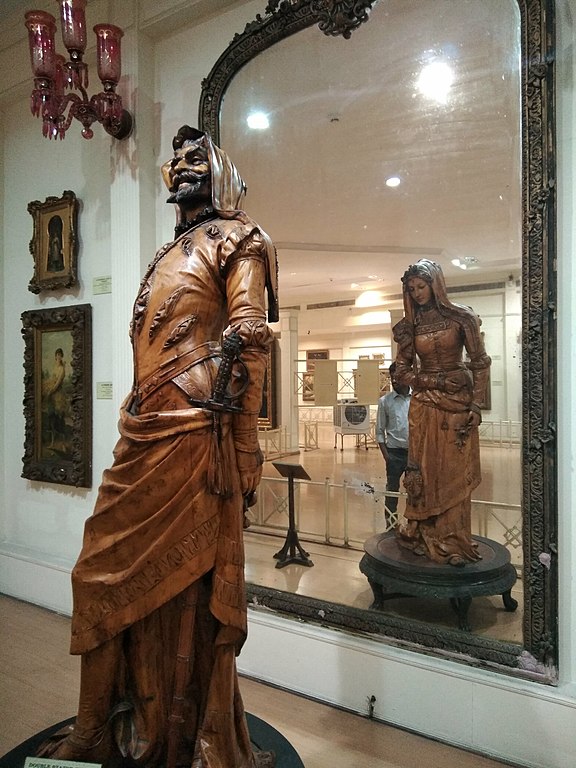
This 19th-century sculpture manages to find two characters from Goethe’s Faust in a single piece of sycamore.
It resides in the Salar Jung Museum in Hyderabad. The artist is unknown.
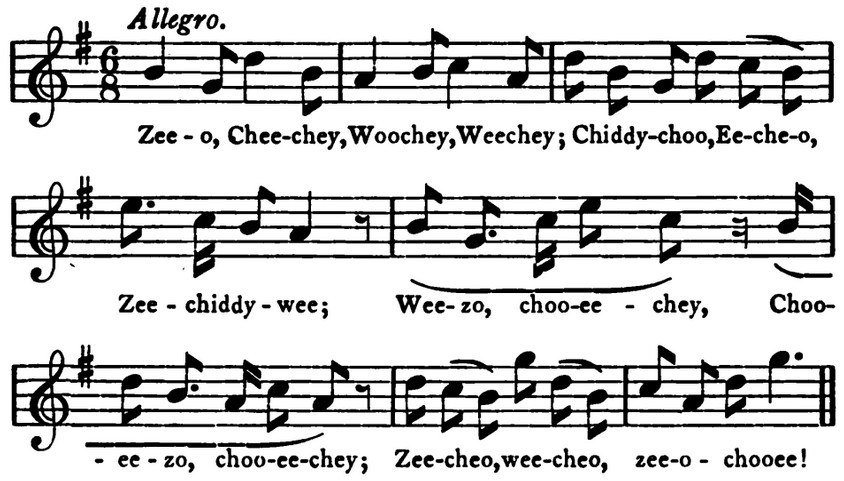
In his 1922 book Songs of the Birds, Oxford zoologist Walter Garstang set out to record birdsongs as musical compositions:
The peculiar quality or timbre of each bird’s voice and the resonance of each sound have been imitated as closely as possible by a selection of human consonants; the composition of the song has been represented by the appropriate repetition, modification, or contrast of selected syllables; the syllabic rendering has been cast in a corresponding rhythm; and round this chosen sequence of syllables a song has been woven to capture something, if possible, of the joy or of the attendant circumstances which form the natural setting of his song.
“I fell in love with my models,” he wrote, “and could not content myself with a purely scientific account of their performances.” He was similarly enraptured by amphibians — the 1951 book Larval Forms collects his poems about marine larvae:
Amblystoma’s a giant newt who rears in swampy waters,
As other newts are wont to do, a lot of fishy daughters:
These Axolotls, having gills, pursue a life aquatic,
But, when they should transform to newts, are naughty and erratic.
His colleague Alister Hardy wrote, “I certainly believe that he gets his ideas across with much greater felicity in these sparkling rhymes than he has done in all his more carefully calculated prose.”
See Bird Songs.
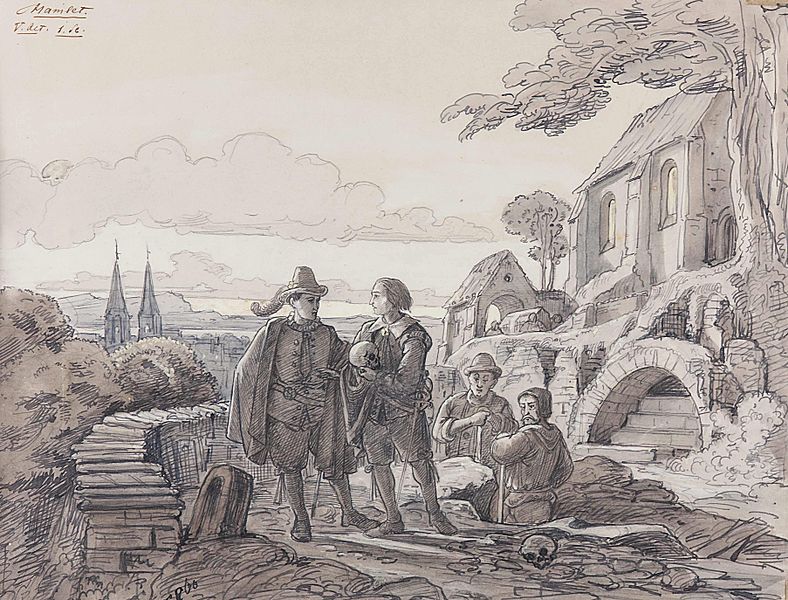
preterlethal
adj. taking place after death
inhume
v. to lay in the grave
janua
n. a door
The principal trap in almost all theatres is known as the grave trap. This is one of the conventionalisms of the English stage, and is a testimony also the enduring influence of Shakespeare. It is well understood that at some time or another the play of ‘Hamlet’ will be performed in every theatre, and Ophelia‘s grave must therefore be dug in every stage — hence the grave trap. It may be that it is not always placed in the right position to suit the ideas of each new representative of the Royal Dane, and it has happened that it has been found too short for the reception of poor Ophelia‘s coffin; but it is never omitted in the construction of a stage.
— Folger Shakespeare Library Scrapbook, quoted in Paul Menzer, Anecdotal Shakespeare, 2015
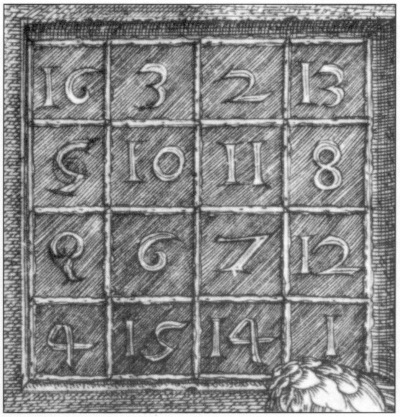
Albrecht Dürer’s 1514 engraving Melencolia I includes this famous magic square: The magic sum of 34 can be reached by adding the numbers in any row, column, diagonal, or quadrant; the four center squares; the four corner squares; the four numbers clockwise from the corners; or the four counterclockwise.
In Power Play (1997), University of Toronto mathematician Ed Barbeau points out that there’s even more magic when we consider squares and cubes. Take the numbers in the first two and the last two rows:
16 + 3 + 2 + 13 + 5 + 10 + 11 + 8 = 9 + 6 + 7 + 12 + 4 + 15 + 14 + 1
162 + 32 + 22 + 132 + 52 + 102 + 112 + 82 = 92 + 62 + 72 + 122 + 42 + 152 + 142 + 12
Or alternate columns:
16 + 5 + 9 + 4 + 2 + 11 + 7 + 14 = 3 + 10 + 6 + 15 + 13 + 8 + 12 + 1
162 + 52 + 92 + 42 + 22 + 112 + 72 + 142 = 32 + 102 + 62 + 152 + 132 + 82 + 122 + 12
Most amazingly, if you compare the numbers on and off the diagonals, this works with both squares and cubes:
16 + 10 + 7 + 1 + 13 + 11 + 6 + 4 = 2 + 3 + 5 + 8 + 9 + 12 + 14 + 15
162 + 102 + 72 + 12 + 132 + 112 + 62 + 42 = 22 + 32 + 52 + 82 + 92 + 122 + 142 + 152
163 + 103 + 73 + 13 + 133 + 113 + 63 + 43 = 23 + 33 + 53 + 83 + 93 + 123 + 143 + 153

Colombian activist César López came up with a striking new peace symbol in 2003 — the escopetarra, a guitar fashioned from a gun.
The word combines the Spanish escopeta (shotgun) and guitarra (guitar). López made the first from a Winchester rifle and a Stratocaster; he’s since built four more and given them to various Latin American artists and cities and to the United Nations, which displayed it at a disarmament conference.
López told the BBC that he got the idea when he saw a soldier carrying his weapon like a guitar. “From there sprang the idea of joining the worst invention of mankind can be joined with the most beautiful,” he said. “Some of the AK-47s have the barrels marked with each of the victims. So we mark the barrels with the songs we play.”
The Treaty of Versailles contained an odd provision: It established a standard pitch to which orchestras could tune. For hundreds of years the agreed pitch might vary widely from one region to the next. When it became clear that the average pitch was rising over time, a French commission settled that the standard pitch for the A above middle C would be 435 hertz, and an 1885 convention of European nations adopted that as an international standard. The Treaty of Versailles in 1919 ratified that decision.
It would change again with time and technology. In the 20th century American musicians came to prefer 440 hertz, and that came to be adopted as the new standard. Today the standard tuning frequency is set by the International Organization for Standardization: ISO 16 “specifies the frequency for the note A in the treble stave and shall be 440 hertz.”
Charles Ives set himself an impossible problem [in his 114 Songs of 1922]. He wanted to use pitch distance to represent the fact that God is infinitely close to man. But what is an infinitesimally close pitch distance? In the end Ives gave up and left it to the singer to decide. Maybe what Ives wanted was a smallest perceptible pitch difference. There is no standard notation for this.
— Wilfrid Hodges, “The Geometry of Music,” in John Fauvel, ed., Music and Mathematics, 2006
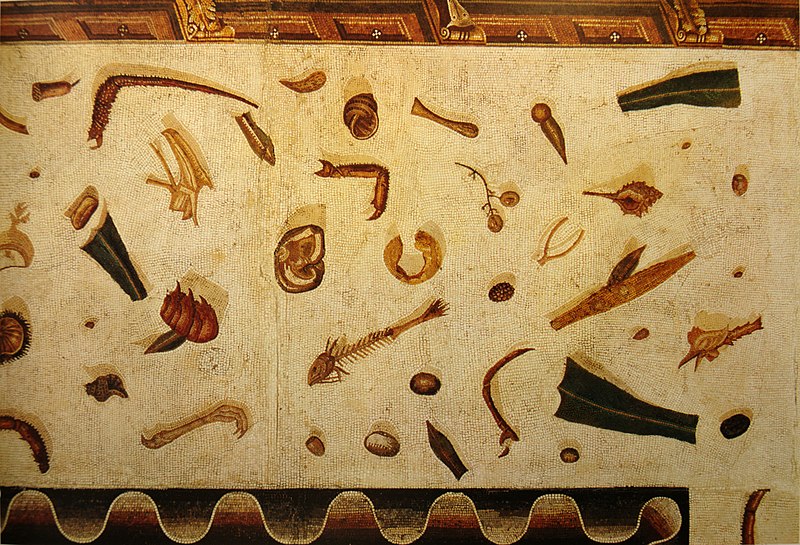
As a joke, Sosus of Pergamon created an “unswept floor” on which the refuse of a dinner table lies scattered.
Sosus laid the original floor at the royal palace in Pergamon in the second century B.C. It quickly became a favorite — wealthy Romans copied it, and it’s the only mosaic mentioned in Pliny’s history of art.
Ballerina Anna Pavlova was famous for creating The Dying Swan, a four-minute solo ballet depicting the last moments in the life of a swan, after the cello solo “Le Cygne” in Camille Saint-Saëns’ Le Carnaval des animaux. She performed the role some 4,000 times; American critic Carl Van Vechten called it “the most exquisite specimen of [Pavlova’s] art which she has yet given to the public.”
Two days after Pavlova’s death in 1931, the orchestra at London’s Apollo Theater paused between selections and began to play “The Death of the Swan.” Dance writer Philip J.S. Richardson recorded what came next:
The curtain went up and disclosed an empty, darkened stage draped in grey hangings, with the spotlight playing on someone who was not there. The large audience rose to its feet and stood in silence while the tune which will forever be associated with Anna Pavlova was played.
“It was an unforgettable moment,” he wrote.